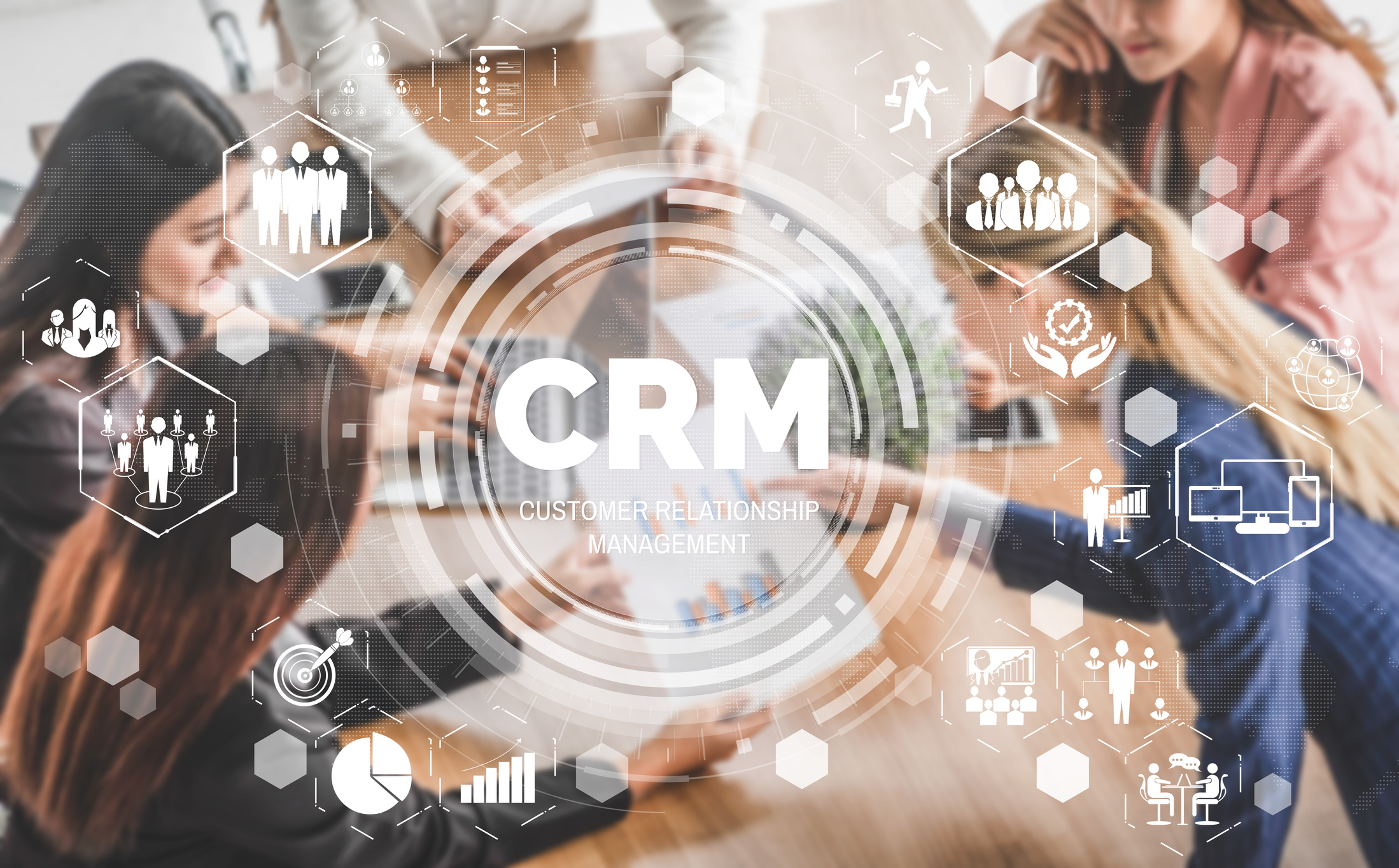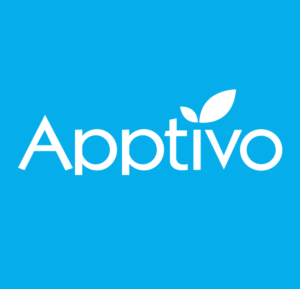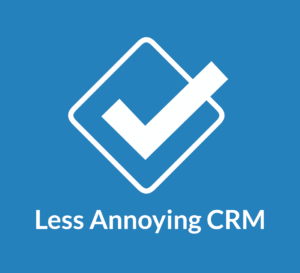
CRM Customer Relationship Management for business sales marketing system concept presented in futuristic graphic interface of service application to support CRM database analysis.
Customer relationship management in a nutshell:
Meeting customers where they are, engaging with them on their own terms, and delivering relevant messages at the right time is the new sales and marketing standard. To do this, you’ll need a customer relationship management (CRM) platform. And a lot depends on getting that right (no pressure!).
CRMs support the strategies, processes, tools and tech to both build and maintain customer relationships. What does this really mean? When done right, the software assembles all of the pieces of a prospect’s journey, from lead through customer, to give sales and marketing a clear picture. CRMs help get your sales team organized, with all customer & prospect data in one place, and they can help track sales activity so that the marketing team can see when a lead or customer was last “touched” by the sales team. They can also help organize your service team, which is another critical touchpoint in the customer experience journey.
So, customer relationship management platforms simplify, automate and optimize (I know, jargon, but it’s true) sales and marketing processes so you can deliver the best experiences possible.
So, what do CRMs actually do?
CRMs offer standard features, like storing identifying information (name, title, you get it) and tracking a person’s engagement history to help you manage leads and customers through the sales funnel. CRMs typically integrate with marketing automation platforms to improve sales and marketing alignment. The results of an effective CRM are great customer experiences that boost conversions (yay), making you a happier marketer and getting you in the good graces of the sales team.
Here are three broad categories of features that you’ll find:
- Operational: These features simplify and automate common sales and marketing tasks, like setting up automated email sequences from a salesperson so they don’t have to manually write and send each email. You can also segment prospects into territories and, if you’re doing ABM, target accounts, for assignment to your sales reps. Operational features are designed to convert cold leads into qualified leads, capturing specifics about them for sales. And sales folks love their hot leads, don’t they?
- Analytical: As analysis machines, CRMs collect data across several touchpoints to help users make better decisions and assess marketing and sales effectiveness. Think: reports, dashboards and data visualizations.
- Collaborative: Customer-centricity (who has this for buzzword bingo?) needs to be company-wide. CRMs with collaborative features make it easier for sales and marketing to talk to the same people without getting their messages crossed.
The benefits of a CRM: Why you’re gonna want one
You can leave a great impression that keeps customers coming back for more…or fumble out a straight-up miserable experience that makes them run for the hills. The disconnect often happens when customer data is incomplete or mismanaged. That’s why a holistic view of your prospective customers, current customers and those precious brand advocates alike matters.
With a single-source platform like a CRM, your customer information is organized, all communications are accessible, and you don’t have to juggle multiple tools that slow productivity. Pretty neat, huh? Your operations become more agile, and both driving sales and improving customer relationships get easier as your CRM organizes your teams.
CRMs deliver better insight into your customers. And with data shared in real time, they bridge department silos, as everyone has free access to the info they need to do their jobs. (And what marketer doesn’t dream of being free?)
Marketers can use CRMs to stalk — I mean, see — the activities of individual customers in real-time. You can quickly develop and deploy personalized experiences for better outcomes (leads and conversions and sales, oh my!).
The integrations available for customer relationship management can even reduce your marketing tech stack vendors and cost…if you choose wisely.
Five leading CRMs: Name dropping
Salesforce: The industry leader in CRM. It’s comprehensive, complex and often costly, but its potential to bring together project management, department organization, and reporting makes this platform shine. Salesforce also owns Pardot, a marketing automation platform, for even better alignment between marketers and the sales team.
Key features:
- Clear views of projects (via content management systems, charts, and calendars)
- Feeds, chat and forums
- Reporting on key performance indicators
- Optimizations for mobile and desktop
- Accessible tasks, subtasks, and timeframes for each assignee
HubSpot CRM: You might know HubSpot as a marketing automation tool, but HubSpot CRM is a full customer relationship management platform with a seamless user interface and good performance. Its “freemium” pricing lets you test it out with the option to add features that grow with you. It’s really convenient to use with other HubSpot products (Marketing Hub, Sales Hub, and Service Hub) and it offers tons of integrations. If you’re having trouble, their support team is also very helpful.
Key features:
- Intuitive interface
- Automated workflows
- Customizable dashboard
- Lots of pre-built integrations
- Good customer support
Zoho CRM: This CRM is a variable beast given its price. The platform is best for small to midsize businesses (SMBs). As one of roughly forty-five software-as-a-service (SaaS) offerings from Zoho, this CRM’s integrations with the company’s other products can easily handle anything you can throw at it.
Key features:
- Gamification (rewards, badges, trophies) to reward hitting targets
- Strong email marketing tools
- Lead management
- Performance forecasts
- Territory management

Key features:
- Customized branding
- Reporting
- Message templates
- Invoicing

Key features:
- Good customer support
- Straightforward pricing plans
- Simple mobile implementations
- Integrations with many popular apps
The challenges of CRM: Not all sunshine and daisies
Getting your company to adopt a new CRM takes effort and a strategy to help users see value. Training and user buy-in are both critical. Set goals and define the ultimate result you want to achieve. Check out our guide to selecting the right martech solutions — it helps break all this down.
Data management needs a team (or at least an owner) to make sure everyone can access the info they need, and that it’s up to date and follows regulations like GDPR. You’ll want to plan data maintenance strategies to catch and remove bad data (think: no more contacts named “Mickey Mouse”). This helps drive adoption and usage, avoiding a data “death spiral” (bad data means fewer people use the tool means more data goes out of date means…you get the point).
Feeling overwhelmed? Relax, because there are tons of additional software to help streamline using CRMs, such as….
Common integrations for CRMs: Let’s all be friends
No CRM is perfect out of the box. Once a platform is operational, workflows may be disorganized (or not do what you thought they would when you built them), your ability to collect data may be limited or your CRM may need to be tweaked to work with other programs.
Integrations bridge gaps in your CRM’s capabilities. This should mean faster adoption, fewer repetitive tasks (win!) and more sales and better customer retention (cha-ching!) through better data use and a clear understanding of your customer.
Some common integrations include:
- Email: Connect your sales team’s daily email to the CRM to track conversations automatically, boosting productivity.
- Calls: Set up call tracking, recording and synced calendars to make it super simple for sales to set appointments and monitor call volume.
- Social media: Boost sales through promotions and increase the amount of collected customer data by tying your social accounts to your CRM.
- Prospect management: Identify audience segments, gather data and provide insights on leads to deliver relevant marketing to them.
- Marketing automation: Break down silos between marketing and sales by easily sharing activity and campaign data.
(Back to) the future of customer relationship management
Forbes reports that 90% of businesses are using artificial intelligence (AI) in marketing, and investors have spent $5 billion in more than 1,400 AI tech companies. This trend toward AI will likely increase in the future, meaning smarter, more predictive campaigns.
At the same time, the use of third-party cookies are going away as more regulations about customer identity protection emerge and come into effect. Econsultancy published a briefing that states, “…the demise of the third-party cookie (nicknamed the “cookiepocalypse”) is now an accepted fact, with discussions turning instead to how marketers can prepare, and what kinds of solutions and alternatives should be adopted.”
Cookiepocalypse is related to similar trends that are driving regulations like the General Data Protection Regulation (GDPR), which protects web users in the European Union (EU) and limits the ways businesses can handle and store customer data. Other regions are set to adopt their own regulations. In the US of A, the California Consumer Privacy Act (CCPA) and the recently-passed CDPA in Virginia are doubling-down on consumer data privacy.
This all means that first-party data (the very kind you gather about your own leads and customers in your CRM) is going to become more critical. AI may enable new features to help marketers maintain compliance and gather data in more transparent ways, but perhaps the best way to navigate these changing data privacy tides is to focus on cleaning your own data warehouse and building a database of opted-in leads and customers who actually want to hear from you.
Content marketing lets you build a narrative as customers travel through your sales funnel, and is useful in gathering customer data from newsletter sign-ups to gated content, webinars are more. Companies can make this happen by thinking more like publishers and by putting out useful content that adds real value to their industry’s conversation.




